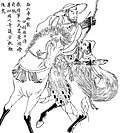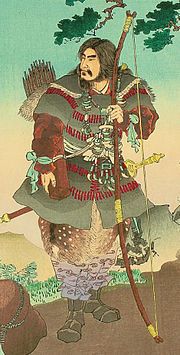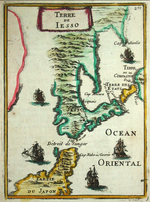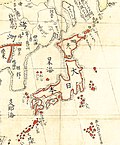The Emishi (蝦夷), also called Ebisu and Ezo, were a people who lived in parts of northern Honshū in present-day Japan, especially in the Tōhoku region....
29 KB (3,630 words) - 16:47, 19 October 2024
Soga no Emishi (蘇我 蝦夷, 587 – July 11, 645) was a statesman of the Yamato imperial court. His alternative names include Emishi (毛人) and Toyora no Ōomi...
2 KB (227 words) - 03:51, 23 May 2024
resorted to other means to conquer the Emishi. Trade for superior quality iron wares and sake made the Emishi dependent on the Japanese for these valuable...
45 KB (3,092 words) - 21:55, 27 September 2024
attacks were launched by the imperial dynasty against the Emishi with little success. In June 787 Emishi cavalry led by Aterui and More surprised and routed...
20 KB (1,504 words) - 00:47, 22 October 2024
These regions are often referred to as Ezochi (蝦夷地) and its inhabitants as Emishi (蝦夷) in historical Japanese texts.They are included in the Jomon cultural...
170 KB (18,903 words) - 04:36, 31 October 2024
southern Hokkaido (700–1200 CE) that has been identified as Emishi, as a Japanese-Emishi mixed culture, as the incipient modern Ainu, or with all three...
6 KB (783 words) - 22:07, 23 June 2024
northern areas from 658 to 660 and came into contact with the Mishihase and Emishi. One of the places Hirafu went to was called Watarishima (渡島), which is...
140 KB (7,517 words) - 03:28, 28 October 2024
(吾妻, あづま) and corresponded to the area of Honshu occupied by the native Emishi and Ainu. The area was historically the Dewa and the Michinoku regions,...
18 KB (1,463 words) - 23:11, 17 October 2024
Northern Fujiwara polity (Ōshū) based in Tōhoku region, having defeated Emishi tribes. This polity existed as Kyoto's internal politics prevented Kyoto's...
20 KB (2,037 words) - 19:31, 17 July 2024
of the Soga were no longer satisfied to act behind the scenes. Soga no Emishi and his son Soga no Iruka began to build increasingly elaborate palaces...
8 KB (948 words) - 13:02, 12 June 2024
most prominent chief of the Isawa (胆沢) band of Emishi in northern Japan.[citation needed] The Emishi were an indigenous people of North Japan, who were...
5 KB (730 words) - 16:14, 23 April 2024
stronghold within Emishi territory in the valley of the Kitakami River. With the defeat of the Emishi chieftain Aterui, many of the Emishi tribes in the Shiwa...
5 KB (448 words) - 20:10, 18 July 2024
people, an ancient group of peoples who inhabited parts of northern Kyushu Emishi, a group of people who lived in the northeastern Tōhoku region of Japan...
47 KB (4,090 words) - 12:41, 21 October 2024
the 12th century as their own realm. They succeeded the semi-independent Emishi families of the 11th century, who were gradually brought down by the Minamoto...
8 KB (812 words) - 23:33, 24 September 2024
Ogushi and a sister of Mononobe no Moriya; they had five children. Soga no Emishi Soga no Kuramaro Kahakami no Iratsume, made consort of Emperor Sushun in...
4 KB (319 words) - 04:35, 21 February 2024
Kiyohira (藤原 清衡, 1056 – August 10, 1128) was a samurai of mixed Japanese-Emishi parentage of the late Heian period (794–1185), who was the founder of the...
6 KB (750 words) - 15:09, 22 September 2024
1336 to 1573 AD) and including fantasy elements, the story follows a young Emishi prince named Ashitaka, and his involvement in a struggle between the gods...
84 KB (7,454 words) - 16:28, 7 November 2024
e Ethnic groups of Japan Prehistoric Jōmon Yayoi Toraijin Ancient Azumi Emishi Hayato Koshibito Kumabito Kumaso Kuzu Mishihase Okhotsk Saeki Satsumon Tsuchigumo...
42 KB (4,736 words) - 09:08, 26 October 2024
Tamuramaro was appointed shōgun and given the task of conquering the Emishi (蝦夷征伐 Emishi Seibatsu), a people native to the north of Honshū, which he subjugated...
10 KB (1,132 words) - 20:44, 25 October 2024
Bidatsu and was supported by the main line of Sogas, including Soga no Emishi. The other, Prince Yamashiro, was a son of Prince Shōtoku and had the support...
16 KB (1,668 words) - 17:34, 24 September 2024
have been the language of one of the peoples known as 'Emishi'; it is not known that the Emishi were a single ethnicity. Bauer, Laurie (2007). The Linguistics...
35 KB (3,406 words) - 14:33, 24 September 2024
Soga no Iruka (蘇我 入鹿) (died July 10, 645) was the son of Soga no Emishi, a statesman in the Asuka Period of Japan. He was assassinated at court in a coup...
2 KB (174 words) - 16:25, 23 April 2024
War (658–660) Yamato State Emishi Mishihase Victory Mishihase were possible recent settlers from Siberia. Yamato and Emishi force defeated Mishihase. (Nihon...
41 KB (429 words) - 06:50, 3 October 2024
Honshu, Japanese military action was portrayed as an effort to "pacify" the Emishi people, who were likened to "bandits" and "wild-hearted wolf cubs" and accused...
56 KB (7,069 words) - 06:31, 7 November 2024
conscription in 792, he still waged major military offensives to subjugate the Emishi, possible descendants of the displaced Jōmon, living in northern and eastern...
38 KB (5,396 words) - 13:51, 28 October 2024
that his armed forces defeated a group of Emishi (蝦夷, 'shrimp barbarians') before his enthronement. The Emishi were an ethnic group who lived in Honshu...
30 KB (3,978 words) - 18:08, 7 November 2024
region, the same two kanji used to write the word Ezo can also be read Emishi. The descendants of these people are most likely related to the Ainu people...
9 KB (956 words) - 14:04, 26 February 2024
e Ethnic groups of Japan Prehistoric Jōmon Yayoi Toraijin Ancient Azumi Emishi Hayato Koshibito Kumabito Kumaso Kuzu Mishihase Okhotsk Saeki Satsumon Tsuchigumo...
96 KB (11,013 words) - 11:15, 28 October 2024
Kenukigata-tachi (ja:毛抜形太刀), which was made by improving Warabitetō (ja:蕨手刀) used by Emishi in Tohoku region. And Kenukigata-tachi evolved into tachi, which became...
10 KB (1,046 words) - 04:02, 13 June 2024
the early Heian period for the duration of military campaigns against the Emishi, who resisted the governance of the Kyoto-based imperial court. Sakanoue...
107 KB (10,995 words) - 08:13, 31 October 2024
























